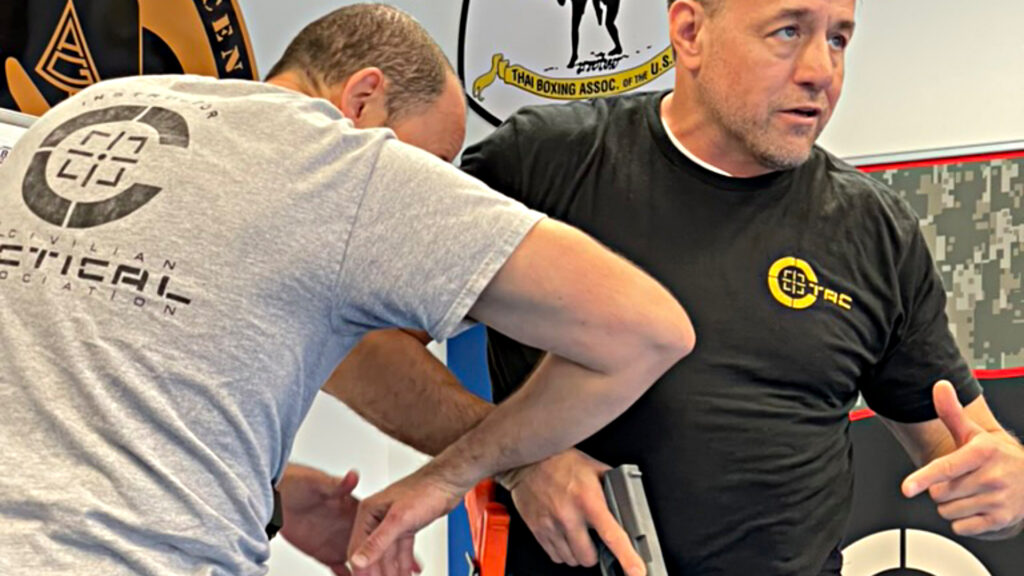
I have trained in Brazilian Jiu-Jitsu, Judo, and Combat Submission Wrestling for over 30 years, with grappling being a particular passion of mine within these disciplines. My journey in martial arts took a significant turn about 15 years ago when I joined the Executive Protection Institute in Virginia as an instructor. This role deepened my involvement in the security, law enforcement, and protection sectors, leading to extensive firearms training.
As I immersed myself in this new environment, I became a staunch advocate for the everyday carry (EDC) philosophy, routinely carrying and training with my firearm to ensure preparedness at all times. This commitment to readiness prompted me to acquire my first EDC Training Kit, which included a training pistol and a straight blade. Integrating this kit into my routine, I incorporated it into all my training sessions, including Brazilian Jiu-Jitsu.
I quickly recognized the need for significant changes in the martial arts I practiced to effectively and sensibly integrate weapons into these settings. Initially, the adjustments were minor, involving tweaks to specific techniques. However, it became clear that a fundamental overhaul was necessary to truly incorporate the concept of weapon retention in a grappling context. I had to revisit and modify the very basics of the system to ensure they were relevant for managing a weapon during close combat. The foundational techniques I had learned at the beginning of my training journey proved inadequate for firearm scenarios, necessitating a comprehensive reevaluation and adaptation to align with the realities of armed self-defense in a grappling situation.
The subsequent shift required was my mindset and the deeply rooted philosophies of the martial arts systems I practiced. For instance, the emphasis on being comfortable on your back in grappling scenarios works well in Brazilian Jiu-Jitsu but proves problematic in armed situations. While Brazilian Jiu-Jitsu trains practitioners to be effective and strategic when fighting from their backs, this approach can be dangerously unsuitable in scenarios where one is armed. Being on your back in an armed confrontation exposes you to significant risks, as it can hinder your ability to control and retain your weapon, making you vulnerable to disarmament or worse. Therefore, I had to critically reassess and adapt these ingrained tactical philosophies to ensure they were practical and safe for situations where weapons are involved. This adaptation meant reevaluating physical techniques and the strategic mindset that governs them, ensuring that they are aligned with the realities of armed self-defense and combat scenarios.
In our training, we also aimed to integrate the capability to exert destructive force from any position encountered during grappling. The basic mechanics initially taught were effective for pure grappling, but once a firearm and the necessity for destructive striking were introduced, a significant transformation of these fundamentals was required. It became crucial to adapt these techniques to ensure the ability to grapple effectively, strike powerfully, and maintain control over the weapon. Moreover, the importance of evading immobilization or restraint took on new significance as maintaining mobility and preventing an adversary from gaining control became paramount in armed grappling scenarios. In sport-based grappling disciplines, the primary objective is to engage in grappling for its own sake; that is, if one needs to escape a position, the aim is to re-enter the grappling fray and re-engage the opponent using grappling techniques. However, this approach might not always be the most effective in a street scenario. Sometimes, grappling must be utilized as a means to transition into a more advantageous position from which to fight (Striking). Grappling and fighting are distinct concepts—while grappling focuses on control and submission, fighting encompasses a broader range of combative techniques, including striking and the use of weapons. In a self-defense context, grappling often serves as a bridge to create opportunities for delivering strikes or other forms of destructive force. Additionally, during such encounters, one must continuously protect their weapon system or, alternatively, work towards regaining their footing, highlighting the need for a tactical approach that balances grappling skills with overall combat readiness.
This journey culminated in a distinct methodology and training regimen for myself. As I gathered and analyzed the data, it became apparent that my developing system diverged significantly from the traditional Brazilian Jiu-Jitsu I had initially learned. Placing the two curricula side by side, the differences in fundamentals and movements were stark. However, this transformation was primarily for my personal development, aimed at ensuring the applicability of my skills in real-life situations.
Over time, this personalized approach to grappling evolved into my unique style. Initially, it was just for my own practice, but eventually, my training partners began to notice the alterations in my techniques during our sessions. Their inquiries about the changes in my approach spurred me to organize my findings, leading to the creation of the Living Mechanics Jiu-Jitsu Curriculum and the Ground Fighting Pourtion of the C-Tac Curriculum. What’s remarkable about this curriculum is its versatility: it can be integrated seamlessly into traditional academy classes. Students can train in these sessions without realizing that they are simultaneously mastering the fundamentals essential for weapon use and retention, as well as effective ground fighting.
The concept of facing multiple opponents is another crucial aspect that warrants attention. Acknowledging the possibility of a second opponent alters the dynamics of the encounter, even when in a dominant grappling position. This realization necessitates adjustments in both technique and strategic outlook to ensure constant awareness of the additional threat. Such multi-opponent scenarios are rarely if ever, addressed in traditional Martial Arts Academies, where the focus is typically on one-on-one engagements. This is sufficient for conventional training, but when the objective shifts towards incorporating tactical elements into one’s regimen, awareness becomes key.
Training must then evolve to not only recognize the presence of multiple adversaries but also to develop and integrate systematic methods for managing this complexity into one’s practice. This approach demands a heightened level of situational awareness and strategic planning, significantly influencing the overall training methodology. Adapting to this broader perspective is essential for ensuring that one’s skills remain effective and applicable in varied and potentially more realistic scenarios.
I hope this article stimulates your thoughts, and if it’s a new concept for you, it prompts you to reassess your training regimen. You might be wondering how to incorporate these strategies into your current practice. We routinely cover these topics in our Living Mechanic and C-Tac Programs. If you’re keen to delve deeper into these areas, we welcome you to contact us through any available communication channels. Your interest in expanding your training dimensions is something we are eager to support and facilitate.
My objective is to expedite the cultivation of the warrior’s mindset and increase the global adoption of the fighter’s mentality. Through the provision of innovative training and knowledge, I strive to prepare individuals for the unpredictability of life and the potential for violent encounters. Moreover, I am dedicated to empowering people to assume full responsibility for every facet of their existence, encouraging them to ascend to greater heights of self-reliance and independence.
Shift Your Perspective, Take the Action, Transform Your World.
~ Sifu Alan
The Warriors Path Podcast With Sifu Alan Baker
Civilian Tactical Training Association Instructors Program

Alan Baker is renowned for his dual expertise in crafting tailored Defensive Tactics Programs and high-performance coaching. Catering specifically to law enforcement agencies, military organizations, and security firms, Alan designs training regimens that emphasize practical techniques, real-world adaptability, and scenario-based training. His approach enhances the capabilities and readiness of personnel in intense situations. Explore Alan’s tailored programs here.
Beyond mere tactics, Alan stands out as the paramount “mindset” coach, adept at unlocking the vast potential within individuals. With a deep passion for mentoring professionals, entrepreneurs, and those on personal growth odysseys, he focuses on nurturing a mindset of excellence. Alan’s coaching hinges on practical strategies that bolster mental resilience, focus, and drive. Teaming up with Alan means embarking on a transformative path where mental barriers are dismantled, inherent strengths come to the fore, and your goals become within clear sight. His profound insights enhance performance and sculpt a mindset tailored for triumphant success.
To delve deeper into Alan’s mindset philosophy, peruse his enlightening collection of books And if you’re ready to amplify your journey under Alan’s tutelage, connect through his official website.

